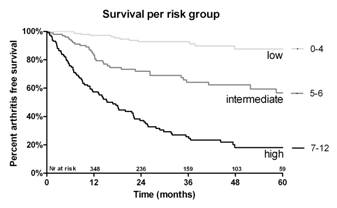Session Information
Title: Rheumatoid Arthritis - Clinical Aspects I: Risk Factors and Prediction of Rheumatoid Arthritis
Session Type: Abstract Submissions (ACR)
Background/Purpose:
Patients presenting with arthralgia and a positive test for anti-cyclic citrullinated peptide antibodies (aCCP) and/or IgM rheumatoid factor (IgM-RF) (seropositive) are at risk for developing RA. We aim to predict the development of arthritis in these patients using antibody characteristics and clinical variables.
Methods:
A prediction rule was developed using a prospective cohort of 374 seropositive arthralgia patients. Patients were followed biannually in the first year and then annually for the development of arthritis, which was defined as presence of one or more swollen joints at clinical examination. 18 prediction variables were selected based on clinical applicability, biologic plausibility, previous research and expert opinion. Backward stepwise Cox regression was used to create a prediction model (p removal 0.1). Regression coefficients were rounded to half points to make a prediction rule. Scores were multiplied by 2 for easier clinical applicability. The diagnostic performance of the prediction rule was evaluated using the area under the curve (AUC) of ROC curves.
Results:
Patients were followed for a median of 32 months (IQR: 13-48). 131 arthralgia patients (35%) developed arthritis after a median of 12 months (IQR: 6-23), of whom 121 (92%) were diagnosed with RA according to the 2010 ACR/EULAR criteria. The prediction model consisted of 9 variables: antibody status (double positive, or high titer aCCP confers higher risk), RA in a first degree family member, VAS pain over 50, presence of morning stiffness, arthralgia in both upper and lower extremities, duration of symptoms shorter than 12 months, presence of intermittent complaints, history of swollen joints as reported by the patient and alcohol non-use. The variables age, sex, smoking, NSAID use, symmetric symptoms, symptoms in small joints, tender joint count, CRP and Shared Epitope were excluded. Patients scored 0 to 12 points on the prediction rule. The AUC value of the prediction rule was 0.82 (95% CI: 0.75-0.89). According to Cox regression analysis with the prediction rule as categorical variable, patients could be categorized in three risk groups: low risk (0-4 points), intermediate risk (5-6 points) and high risk (7-12 points). 155 (41%) patients had low, 102 (27%) intermediate and 117 (31%) had high risk. The percentages of arthritis development per risk group are depicted in the figure. With the low risk group as a reference, the intermediate risk group had a hazard ratio (HR; 95% CI) of 4.3 (2.3-8.1) and the high risk group had a HR of 14 (7.7 – 25).
Conclusion:
In patients who present with seropositive arthralgia, the risk of developing arthritis and subsequent RA can be predicted. The prediction rule that was made in this patient group can help 1) to inform patients and 2) to select high-risk patients for intervention studies before clinical arthritis occurs.
Disclosure:
L. van de Stadt,
None;
B. I. Witte,
None;
W. H. Bos,
None;
D. van Schaardenburg,
None.
« Back to 2012 ACR/ARHP Annual Meeting
ACR Meeting Abstracts - https://acrabstracts.org/abstract/a-prediction-rule-for-the-development-of-rheumatoid-arthritis-a-prospective-cohort-study-of-seropositive-arthralgia-patients/

